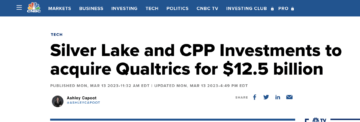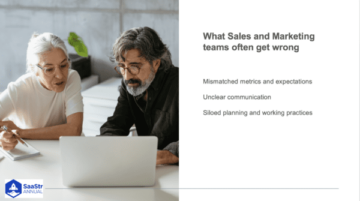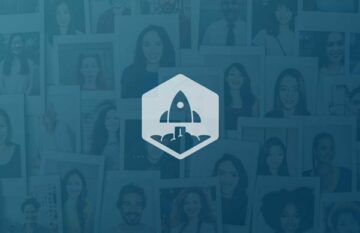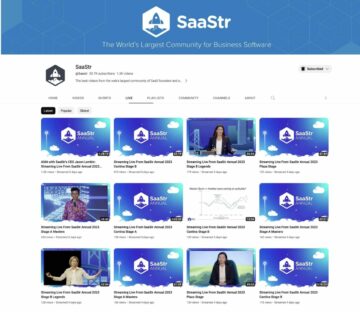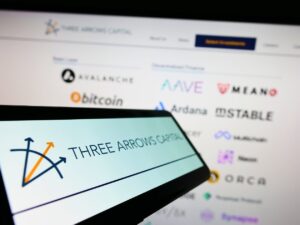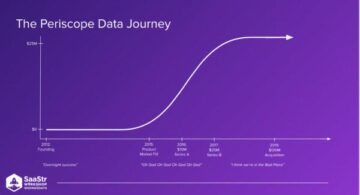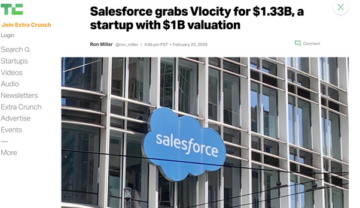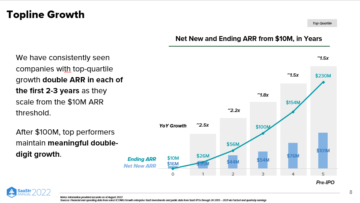
Co-founder and CEO at Greenhouse, Daniel Chait, sits down with SaaStr CEO and Founder Jason Lemkin to share what’s new at Greenhouse, a successful recruiting software company at $200M in ARR today.
When Greenhouse started, it was at a time when the market was growing up, and there weren’t any playbooks. You could do vanilla 101 SaaS practices and succeed.
Could something like the Greenhouse of 2015 even make it to market today?
Who knows. Getting off the ground is one thing — an easy pitch of being an HR tech startup focused on improving hiring.
But today, it’s not that easy anymore.
Today, if your product is easy to use, people will try it.
It’s easy to get to $10M or $15M ARR, but the problem is… What happens next?
In the ATS industry, buyers might choose the cool, new, shiny, and cheaper product. That’s a great pitch, so every year, a new and cheaper flavor comes out.
The problem is if you’re in business for any amount of time, the product gets a bit older. Hiring is complicated, so you have to build a lot of software to get to $200M ARR.
It’s challenging to be easy to use, simple, and big.
You have to be intentional in your strategy to solve for the long tail.
Greenhouse intended to be multi-segment, even though it’s a tradeoff. In a year like this, SMB is doing worse, with a lot more churn and startups going out of business.
On the other hand, their Enterprise segment is bigger and doing great.
But in other years, SMBs are jumping in the boat, so you get amazing growth long-term with a multi-segment strategy.
The great part about having a couple of thousand startups using your product every day is there is so much innovation.
The SMB markets can test out features that aren’t built to scale yet, and as they succeed, Greenhouse invests in them and rolls them out to Enterprise customers.
Something folks yo-yo on as they scale is the idea of putting all of your money into Enterprise marketing when the majority of revenue is coming from Enterprise.
The yo-yo comes when they realize they aren’t putting enough into startups, and people don’t always find them later. You have to do upmarket and then rotate back.
Does Greenhouse want to capture these people with just a few million or even less in revenue so they stay for life? Yes. When looking at Greenhouse’s Enterprise business, many of them started when they were tiny. A huge amount of their mid-market was SMB just a few years ago, so it’s worth looking at the true lifetime value of those companies.
Sometimes, it might look like SMB churn when they’re really just moving into mid-market.
The swing nature is true for where to invest marketing dollars, so founders need to be thoughtful when running a portfolio of bets. You have to place a few chips in each square and be consistent over time.
The biggest theme at SaaStr Annual this year was multi-product. Everyone was talking about it.
Is Greenhouse multi-product? Not quite yet. Their core product’s TAM is pretty darn big. Their flagship software is the bulk of their business and could get them to a billion in revenue. Per Daniel, getting from $200M to $400M doesn’t require any imagination.
To get to a billion of ARR just on an ATS business though might require some imagination.
The first decade of Greenhouse was focused on winning the ATS market. Check! They did it.
Now, over the next decade, they need to think about other things their customers do in hiring that aren’t done well and could be scaled.
In the early stages of Greenhouse, they knew hiring was a big problem and worth a lot of money.
The ATS business failed to solve the hiring problem, and they knew they could do something different. For the first six months, they didn’t think they’d build an ATS at all because it didn’t seem relevant to the problem. But buyers buy exactly one ATS and never two, so as much as they didn’t want to be an ATS business, they were.
Two places Daniel could discover their TAM were:
- On LinkedIn. All of their buyers are on LinkedIn.
- On websites. He could go to any website careers page and learn about the incumbent and what they were hiring for.
It was a very addressable market worth doing if they saw it as a vehicle for a larger problem they were going to solve.
At the time, there wasn’t a huge successful ATS business. Now, there are at least three with plus a billion dollar valuations.
That wasn’t obvious in 2012.
Even saying the word ATS is a growth journey for Daniel. He didn’t want to say the word. At first, while he and co-founder Jon Stross wanted to reimagine hiring, they didn’t want to build an “ATS” (Applicant Tracking Service) per se. He ran from the term.
But on sales calls, the buyer would say the product looked amazing — and that they needed an ATS before buying Greenhouse. Without realizing Greenhouse was an ATS, too.
Why is that important?
Because you have to learn the language of your buyers. And it’s different from the language of investors and your visions, which goes to your employees and yourself.
In software, there are buckets — a CRM bucket, an HRM bucket, an ATS bucket.
As founders, we want to make categories and innovate, but it’s usually better to do it in a bucket.
Buyers have been buying these buckets for twenty years and are rebuying them.
It’s already a ton of energy to buy your category within a bucket. It’s even more energy to train people in an entirely new bucket.
AI has burst on the scene, and everyone’s rushing to add a ChatGPT-like thing to their product.
Greenhouse is no different.
Of course, when you have a paradigm shift of an old version and new version, before the internet and after the internet, before AI and after AI, things eventually get folded down into the main stack.
People want reporting, but Greenhouse is taking it a step further.
Greenhouse wants to use AI to improve fairness.
If you’re not fairly assessing candidates, you’re missing out on great talent.
There’s so much bias in AI models. Folks say they’ll take AI and filter top-of-funnel. That’s a disaster and will magnify any bias in that database.
Greenhouse is combating this with a patent on a new machine learning-based resume parser to increase accuracy.
When thinking about hiring, so many resumes are coming in, and parsing is only one part.
Could there be a way to use AI to find hidden gems? How many applicants are big companies processing?
At Greenhouse, their customer base can get overwhelmed with applicants, while others are starving for candidates.
There’s a real opportunity to focus on the right candidates.
AI can be a dangerous way to find the “right” candidates because of biases.
But some other options exist, like automatic taxonomy.
If one resume says software engineer and the other says developer, AI can converge these skills so people don’t slip through the cracks because they typed a title incorrectly.
As a CEO of a company with $200M in revenue, you have to leverage your team.
As a CEO, no one can do what you do because no one else is the founder of your company.
This role gives you a certain kind of power in any room you want to take advantage of.
Daniel doesn’t make their products, write product roadmaps, sell a single copy of Greenhouse, or manage customer accounts. He can’t do anything the company does anymore, but he does show up as the CEO and add value to a room based on his role in the company.
If you can find people on your team who add value to your life and help you get out of the weeds, that’s a big unlock in hiring.
Daniel’s team is an anti-gravity device. He doesn’t get weighed down in their world or fix their stuff.
As founders, you should find people who can run things well and solve problems while you’re away.
Salesforce just announced they were rehiring 2,000 people they laid off, and Samsara, a rocket ship, way under-hired for sales reps. Let’s look at the trends Greenhouse is seeing in Enterprise, mid-market, and SMB over the last 12 months.
There’s been a lot of stress on small businesses and VC-backed small companies.
The era of free money is over.
Vendors are seeing churn because many companies are going out of business.
But TechCrunch doesn’t represent the entire world. The U.S. has 3% unemployment.
Greenhouse over-indexes on knowledge workers like management consultants, finance companies, advertising, marketing, and other companies with similar talent characteristics of a tech company.
Those industries are hiring less, going out of business, and experiencing more layoffs.
The impact has stopped getting worse but isn’t getting better yet.
Enterprise is seeing a lot more positive and healthy trend because they won’t go out of business from interest rates going up a few points.
Some of them may have gotten too lean, so if you’re still growing, you have to keep up with it.
Layoffs were about quickly getting lean and fit and making Wall Street happy, but there will likely be a quiet reflation in 2024 because no one can freeze for two years and still grow.
Greenhouse was bad for three weeks and was very good for two years. Texas Pacific Group bought investors out for close to a billion dollars all in.
Two years later, Daniel is still CEO and gets liquidity as part of the deal.
For certain founders, it’s not perfect, but it’s the best of both worlds — some liquidity and getting to play another card.
Daniel’s advice for startup founders is that your opportunities for liquidity are few and far between.
Some people wrestle with the idea that they’re leaving money on the table or hoping it triples along the way. But you might not get another bite of the apple. Not all Private Equity is the same. Some founders stay, while others leave the day after IPO.
For the average PE investor, they want a triple, not a grand slam. It’s a different feel than a VC because the PE wants to manufacture consistent wins.
Daniel chose this route because it was a growth fund focusing on social impact, not a buyout fund.
All in all, every startup founder has to choose the best path forward for themselves and their companies. Greenhouse continues to grow and release exciting new features.
- SEO Powered Content & PR Distribution. Get Amplified Today.
- PlatoData.Network Vertical Generative Ai. Empower Yourself. Access Here.
- PlatoAiStream. Web3 Intelligence. Knowledge Amplified. Access Here.
- PlatoESG. Carbon, CleanTech, Energy, Environment, Solar, Waste Management. Access Here.
- PlatoHealth. Biotech and Clinical Trials Intelligence. Access Here.
- Source: https://www.saastr.com/whats-new-at-greenhouse-200m-arr-ai-in-the-real-world-getting-bought-by-pe/
- :has
- :is
- :not
- :where
- $UP
- 000
- 1
- 12
- 12 months
- 2012
- 2015
- 2024
- a
- About
- about IT
- Accounts
- accuracy
- add
- addressable
- ADvantage
- Advertising
- advice
- After
- ago
- AI
- AI models
- All
- along
- already
- always
- amazing
- amount
- an
- and
- announced
- annual
- Another
- any
- anymore
- anything
- Apple
- applicants
- ARE
- AS
- Assessing
- At
- ATS
- Automatic
- average
- away
- back
- Bad
- base
- based
- BE
- because
- been
- before
- being
- BEST
- Bets
- Better
- between
- bias
- biases
- Big
- bigger
- Biggest
- Billion
- Bit
- boat
- both
- bought
- build
- built
- business
- businesses
- but
- buy
- BUYER..
- buyers
- Buying
- Buyout
- Calls
- CAN
- Can Get
- candidates
- capture
- card
- careers
- categories
- Category
- ceo
- CEO and Founder
- certain
- challenging
- characteristics
- cheaper
- Chips
- Choose
- chose
- Close
- Co-founder
- combating
- comes
- coming
- Companies
- company
- complicated
- consistent
- consultants
- content
- continues
- converge
- Cool
- Core
- could
- Couple
- course
- CRM
- customer
- Customers
- Dangerous
- Daniel
- data
- Database
- day
- deal
- decade
- Developer
- device
- DID
- different
- disaster
- discover
- do
- does
- Doesn’t
- doing
- Dollar
- dollars
- done
- Dont
- down
- each
- Early
- easy
- else
- embedded
- employees
- energy
- engineer
- enough
- Enterprise
- enterprise customers
- Entire
- entirely
- equity
- Era
- Even
- eventually
- Every
- every day
- everyone
- everyone’s
- exactly
- exciting
- exist
- experiencing
- Failed
- fairly
- fairness
- far
- Features
- feel
- few
- filter
- finance
- Find
- First
- fit
- Fix
- flagship
- Focus
- focused
- focusing
- For
- Forward
- founder
- founders
- Free
- Freeze
- from
- fund
- further
- get
- getting
- gives
- Go
- Goes
- going
- good
- grand
- great
- Ground
- Group
- Grow
- Growing
- Growth
- hand
- happens
- happy
- Have
- having
- he
- healthy
- help
- Hidden
- Hiring
- his
- hoping
- How
- hr
- HR Tech
- HTTPS
- huge
- idea
- if
- imagination
- Impact
- important
- improve
- improving
- in
- In other
- incorrectly
- Increase
- Incumbent
- industries
- industry
- innovate
- Innovation
- intended
- Intentional
- interest
- Interest Rates
- Internet
- into
- Invest
- investor
- Investors
- Invests
- IPO
- IT
- jon
- journey
- just
- Keep
- Kind
- knowledge
- knows
- language
- larger
- Last
- later
- layoffs
- LEARN
- least
- Leave
- leaving
- less
- Leverage
- Life
- lifetime
- like
- likely
- Liquidity
- Long
- long-term
- Look
- look like
- looked
- looking
- Lot
- machine
- Main
- Majority
- make
- Making
- manage
- management
- many
- Market
- Marketing
- Markets
- May..
- mid-market
- might
- million
- missing
- models
- money
- months
- more
- moving
- much
- Nature
- Need
- needed
- never
- New
- New Features
- next
- no
- now
- obvious
- of
- off
- Old
- older
- on
- ONE
- only
- opportunities
- Opportunity
- Options
- or
- Other
- Others
- out
- over
- overwhelmed
- P&E
- Pacific
- page
- paradigm
- part
- patent
- path
- People
- per
- perfect
- Pitch
- Place
- Places
- plato
- Plato Data Intelligence
- PlatoData
- Play
- plus
- points
- portfolio
- positive
- power
- practices
- pretty
- private
- Private Equity
- Problem
- problems
- processing
- Product
- Products
- Putting
- quickly
- quite
- Rates
- real
- realize
- realizing
- really
- recruiting
- release
- relevant
- Reporting
- represent
- require
- resume
- resume parser
- revenue
- right
- roadmaps
- rocket
- Role
- rolls
- Room
- Route
- Run
- running
- s
- SaaS
- sales
- same
- saw
- say
- saying
- says
- Scale
- scene
- seeing
- seem
- segment
- sell
- service
- Share
- shift
- should
- show
- similar
- Simple
- single
- sits
- SIX
- Six months
- skills
- small
- small businesses
- SMB
- SMBs
- So
- Social
- Social impact
- Software
- Software Engineer
- SOLVE
- some
- something
- square
- stack
- stages
- started
- startup
- Startups
- stay
- Step
- Still
- stopped
- Strategy
- street
- stress
- succeed
- successful
- Swing
- table
- Take
- taking
- Talent
- talking
- TAM
- taxonomy
- team
- tech
- Tech Company
- tech startup
- TechCrunch
- term
- test
- texas
- than
- that
- The
- their
- Them
- theme
- themselves
- then
- There.
- These
- they
- thing
- things
- Think
- Thinking
- this
- this year
- those
- though?
- thousand
- three
- Through
- time
- Title
- to
- today
- Ton
- too
- Tracking
- Train
- Trend
- Trends
- Triple
- triples
- true
- try
- twenty
- two
- u.s.
- unemployment
- unlock
- use
- using
- usually
- Valuations
- value
- VC
- vehicle
- version
- very
- visions
- Wall
- Wall Street
- want
- wanted
- wants
- was
- Way..
- we
- Website
- websites
- Weeks
- WELL
- were
- What
- when
- which
- while
- WHO
- will
- winning
- Wins
- with
- within
- Word
- workers
- world
- world’s
- worse
- worth
- would
- write
- year
- years
- yet
- you
- Your
- yourself
- youtube
- zephyrnet

